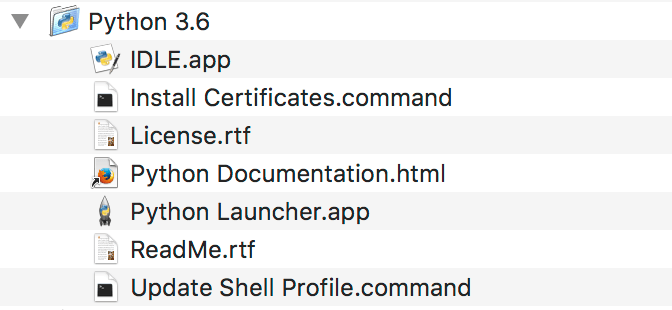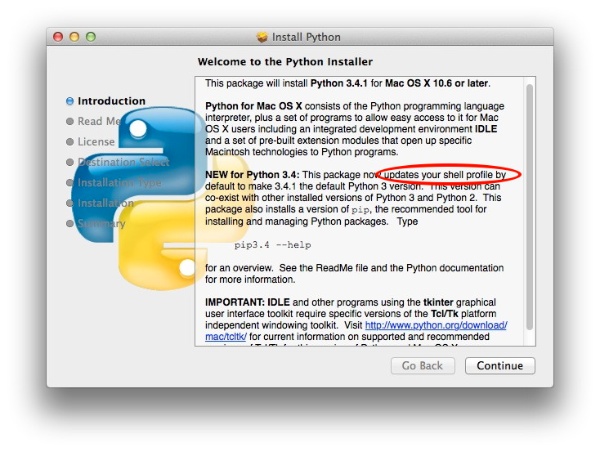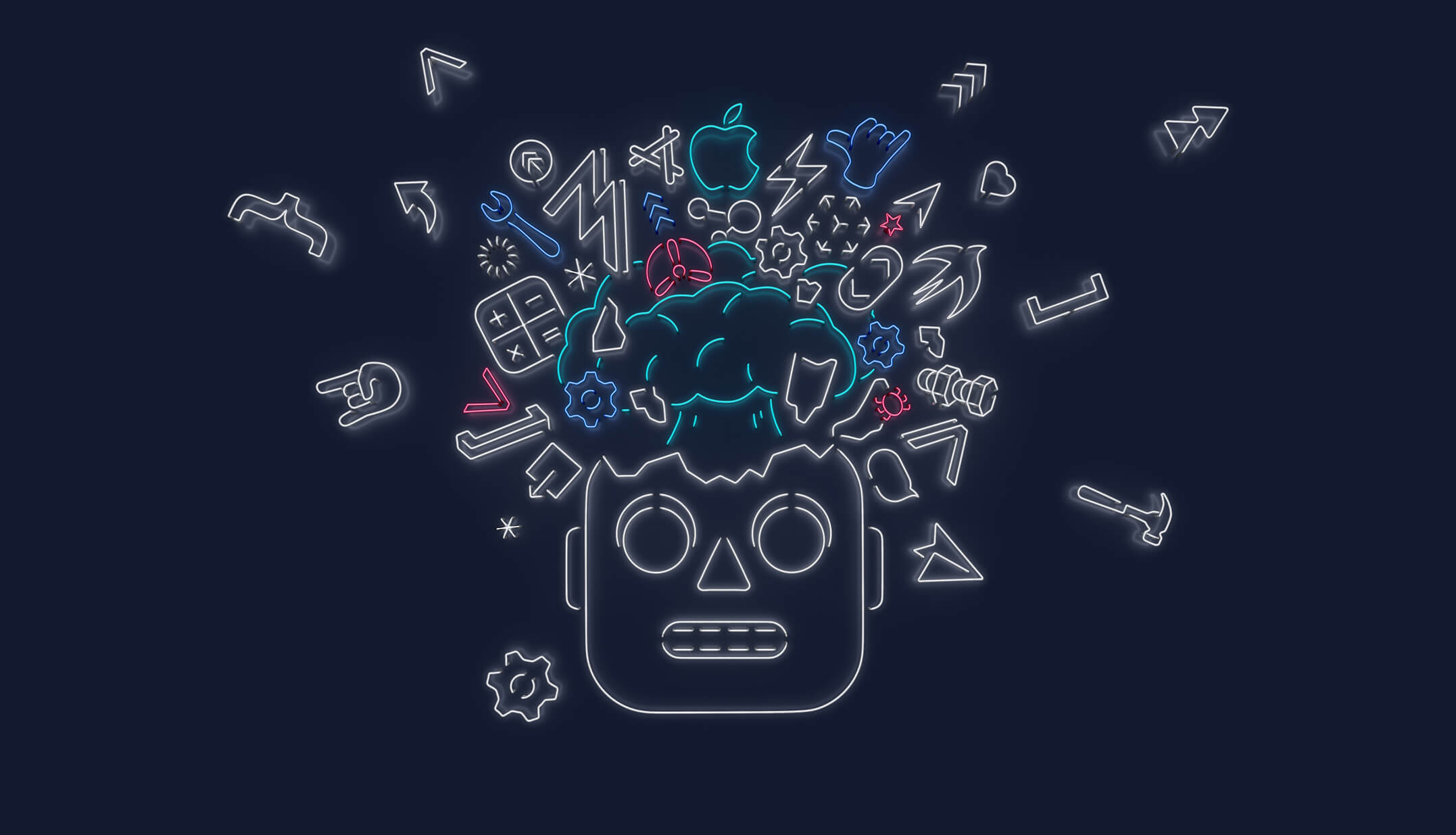Install Python 3 For Mac
Release Date: Aug. 17, 2020
Python 3.7.9 is the latest security fix release of Python 3.7.
Python 3.8 is now the latest feature release series of Python 3. Get the latest release of 3.8.x here. Python 3.7.8 was the last bugfix release for 3.7. Python 3.7 is now in the security fix phase of its life cycle. Only security-related issues are accepted and addressed during this phase. We plan to provide security fixes for Python 3.7 as needed until mid 2023, five years following its initial release. Security fix releases are produced periodically as needed and are source-only releases.
Binary installers are normally not provided for security fix releases. However, since 3.7.8 was the last 3.7.x bugfix release and there are security fixes published in 3.7.9 that apply to users of some of the binary installers provided with 3.7.8, we have made an exception for 3.7.9 and are also updating the Windows and macOS binary installers. We do not plan to provide further binary updates for future 3.7.x security releases.
Please see the Full Changelog link for more information about the contents of this release and see What’s New In Python 3.7 for more information about 3.7 features.
- PEP 537, 3.7 Release Schedule
- Report bugs at https://bugs.python.org.
- Help fund Python and its community.
This video explains how to install Python 3 in a Mac OS X, both Mavericks and Yosemite. As the Python website says, 'Python 2.x is legacy, Python 3.x is the. The same source code archive can also be used to build the Windows and Mac versions, and is the starting point for ports to all other platforms. Download the latest Python 3 and Python 2 source. Gpg -verify Python-3.6.2.tgz.asc. Installing Python 3 on Mac OS X. These instructions document the installation of Python 3. The version of Python that ships with OS X is great for learning, but it’s not good for development. The version shipped with OS X may be out of date from the official current Python release.
More from Raghav - How to install Python on MacOS Step by Step for Beginners Today we will learn: 1. Check if Python is alr. Download the latest version of Python for Mac. A practical, multiparadigm programming language. Python is a free, open-source interpreted language that stands. Python is an easy-to-use language with a gently sloping learning curve. It uses an elegant syntax that allows for easy.
- The binaries for AMD64 will also work on processors that implement the Intel 64 architecture. (Also known as the 'x64' architecture, and formerly known as both 'EM64T' and 'x86-64'.)
- There are now 'web-based' installers for Windows platforms; the installer will download the needed software components at installation time.
- There are redistributable zip files containing the Windows builds, making it easy to redistribute Python as part of another software package. Please see the documentation regarding Embedded Distribution for more information.
- Please read the 'Important Information' displayed during installation for information about SSL/TLS certificate validation and the running the 'Install Certificates.command'.
- As of 3.7.7, we provide one installer: 64-bit-only that works on macOS 10.9 (Mavericks) and later systems. The deprecated 64-bit/32-bit installer variant for macOS 10.6 (Snow Leopard) is no longer provided.
- As of 3.7.7, macOS installer packages are now compatible with the full Gatekeeper notarization requirements of macOS 10.15 Catalina including code signing.
| Version | Operating System | Description | MD5 Sum | File Size | GPG |
|---|---|---|---|---|---|
| Gzipped source tarball | Source release | bcd9f22cf531efc6f06ca6b9b2919bd4 | 23277790 | SIG | |
| XZ compressed source tarball | Source release | 389d3ed26b4d97c741d9e5423da1f43b | 17389636 | SIG | |
| macOS 64-bit installer | Mac OS X | for OS X 10.9 and later | 4b544fc0ac8c3cffdb67dede23ddb79e | 29305353 | SIG |
| Windows help file | Windows | 1094c8d9438ad1adc263ca57ceb3b927 | 8186795 | SIG | |
| Windows x86-64 embeddable zip file | Windows | for AMD64/EM64T/x64 | 60f77740b30030b22699dbd14883a4a3 | 7502379 | SIG |
| Windows x86-64 executable installer | Windows | for AMD64/EM64T/x64 | 7083fed513c3c9a4ea655211df9ade27 | 26940592 | SIG |
| Windows x86-64 web-based installer | Windows | for AMD64/EM64T/x64 | da0b17ae84d6579f8df3eb24927fd825 | 1348904 | SIG |
| Windows x86 embeddable zip file | Windows | 97c6558d479dc53bf448580b66ad7c1e | 6659999 | SIG | |
| Windows x86 executable installer | Windows | 1e6d31c98c68c723541f0821b3c15d52 | 25875560 | SIG | |
| Windows x86 web-based installer | Windows | 22f68f09e533c4940fc006e035f08aa2 | 1319904 | SIG |
Bob Savage <bobsavage@mac.com>
Python on a Macintosh running Mac OS X is in principle very similar to Python onany other Unix platform, but there are a number of additional features such asthe IDE and the Package Manager that are worth pointing out.

4.1. Getting and Installing MacPython¶
Mac OS X 10.8 comes with Python 2.7 pre-installed by Apple. If you wish, youare invited to install the most recent version of Python 3 from the Pythonwebsite (https://www.python.org). A current “universal binary” build of Python,which runs natively on the Mac’s new Intel and legacy PPC CPU’s, is availablethere.
What you get after installing is a number of things:
A
Python3.9folder in yourApplicationsfolder. In hereyou find IDLE, the development environment that is a standard part of officialPython distributions; and PythonLauncher, which handles double-clicking Pythonscripts from the Finder.A framework
/Library/Frameworks/Python.framework, which includes thePython executable and libraries. The installer adds this location to your shellpath. To uninstall MacPython, you can simply remove these three things. Asymlink to the Python executable is placed in /usr/local/bin/.
The Apple-provided build of Python is installed in/System/Library/Frameworks/Python.framework and /usr/bin/python,respectively. You should never modify or delete these, as they areApple-controlled and are used by Apple- or third-party software. Remember thatif you choose to install a newer Python version from python.org, you will havetwo different but functional Python installations on your computer, so it willbe important that your paths and usages are consistent with what you want to do.
IDLE includes a help menu that allows you to access Python documentation. If youare completely new to Python you should start reading the tutorial introductionin that document.
If you are familiar with Python on other Unix platforms you should read thesection on running Python scripts from the Unix shell.
4.1.1. How to run a Python script¶
Your best way to get started with Python on Mac OS X is through the IDLEintegrated development environment, see section The IDE and use the Help menuwhen the IDE is running.
If you want to run Python scripts from the Terminal window command line or fromthe Finder you first need an editor to create your script. Mac OS X comes with anumber of standard Unix command line editors, vim andemacs among them. If you want a more Mac-like editor,BBEdit or TextWrangler from Bare Bones Software (seehttp://www.barebones.com/products/bbedit/index.html) are good choices, as isTextMate (see https://macromates.com/). Other editors includeGvim (http://macvim-dev.github.io/macvim/) and Aquamacs(http://aquamacs.org/).
To run your script from the Terminal window you must make sure that/usr/local/bin is in your shell search path.
To run your script from the Finder you have two options:
Drag it to PythonLauncher
Select PythonLauncher as the default application to open yourscript (or any .py script) through the finder Info window and double-click it.PythonLauncher has various preferences to control how your script islaunched. Option-dragging allows you to change these for one invocation, or useits Preferences menu to change things globally.
4.1.2. Running scripts with a GUI¶
With older versions of Python, there is one Mac OS X quirk that you need to beaware of: programs that talk to the Aqua window manager (in other words,anything that has a GUI) need to be run in a special way. Use pythonwinstead of python to start such scripts.
With Python 3.9, you can use either python or pythonw.
4.1.3. Configuration¶
Install Pip Macos
Python on OS X honors all standard Unix environment variables such asPYTHONPATH, but setting these variables for programs started from theFinder is non-standard as the Finder does not read your .profile or.cshrc at startup. You need to create a file~/.MacOSX/environment.plist. See Apple’s Technical Document QA1067 fordetails.
For more information on installation Python packages in MacPython, see sectionInstalling Additional Python Packages.
4.2. The IDE¶
MacPython ships with the standard IDLE development environment. A goodintroduction to using IDLE can be found athttp://www.hashcollision.org/hkn/python/idle_intro/index.html.
4.3. Installing Additional Python Packages¶
There are several methods to install additional Python packages:
Packages can be installed via the standard Python distutils mode (
pythonsetup.pyinstall).Many packages can also be installed via the setuptools extensionor pip wrapper, see https://pip.pypa.io/.
4.4. GUI Programming on the Mac¶
There are several options for building GUI applications on the Mac with Python.
PyObjC is a Python binding to Apple’s Objective-C/Cocoa framework, which isthe foundation of most modern Mac development. Information on PyObjC isavailable from https://pypi.org/project/pyobjc/.

Install Python 3 Mac Pip
The standard Python GUI toolkit is tkinter, based on the cross-platformTk toolkit (https://www.tcl.tk). An Aqua-native version of Tk is bundled with OSX by Apple, and the latest version can be downloaded and installed fromhttps://www.activestate.com; it can also be built from source.
wxPython is another popular cross-platform GUI toolkit that runs natively onMac OS X. Packages and documentation are available from https://www.wxpython.org.
PyQt is another popular cross-platform GUI toolkit that runs natively on MacOS X. More information can be found athttps://riverbankcomputing.com/software/pyqt/intro.

4.5. Distributing Python Applications on the Mac¶
The standard tool for deploying standalone Python applications on the Mac ispy2app. More information on installing and using py2app can be foundat http://undefined.org/python/#py2app.
Python 3.8 Mac
4.6. Other Resources¶
The MacPython mailing list is an excellent support resource for Python users anddevelopers on the Mac:

Another useful resource is the MacPython wiki:
